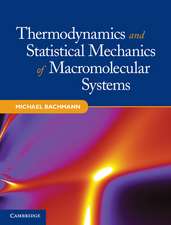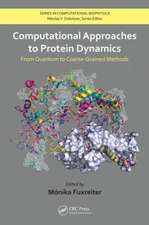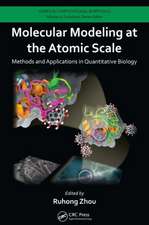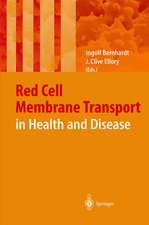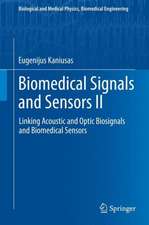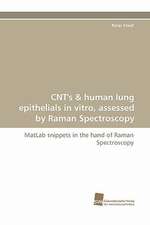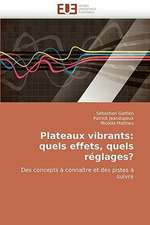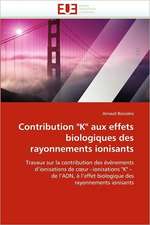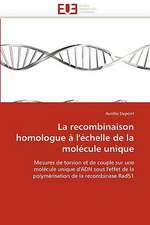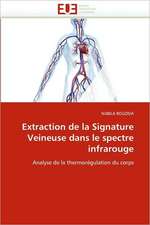Biomedical Signals and Sensors III: Linking Electric Biosignals and Biomedical Sensors: Biological and Medical Physics, Biomedical Engineering
Autor Eugenijus Kaniusasen Limba Engleză Hardback – 30 aug 2019
Readers will learn how these electric, magnetic and electromagnetic fields propagate and interact with biological tissues, are influenced by inhomogeneity effects, cause neuromuscular stimulation and thermal effects, and finally pass the electrode/tissue boundary to be recorded. As such, the book helps them manage the challenges posed by the highly interdisciplinary nature of biosignals and biomedical sensors by presenting the basics of electrical engineering, physics, biology and physiology that are needed to understand the relevant phenomena.
Din seria Biological and Medical Physics, Biomedical Engineering
- 5%
 Preț: 1110.32 lei
Preț: 1110.32 lei - 18%
 Preț: 1006.55 lei
Preț: 1006.55 lei - 18%
 Preț: 960.78 lei
Preț: 960.78 lei - 18%
 Preț: 704.11 lei
Preț: 704.11 lei - 18%
 Preț: 967.40 lei
Preț: 967.40 lei - 18%
 Preț: 948.92 lei
Preț: 948.92 lei - 15%
 Preț: 641.71 lei
Preț: 641.71 lei - 15%
 Preț: 644.95 lei
Preț: 644.95 lei - 15%
 Preț: 665.08 lei
Preț: 665.08 lei - 18%
 Preț: 1669.16 lei
Preț: 1669.16 lei - 18%
 Preț: 941.05 lei
Preț: 941.05 lei - 18%
 Preț: 956.81 lei
Preț: 956.81 lei - 18%
 Preț: 950.21 lei
Preț: 950.21 lei - 15%
 Preț: 636.80 lei
Preț: 636.80 lei - 18%
 Preț: 947.50 lei
Preț: 947.50 lei - 15%
 Preț: 636.80 lei
Preț: 636.80 lei -
 Preț: 397.01 lei
Preț: 397.01 lei - 18%
 Preț: 1236.99 lei
Preț: 1236.99 lei - 15%
 Preț: 644.49 lei
Preț: 644.49 lei - 18%
 Preț: 946.55 lei
Preț: 946.55 lei - 15%
 Preț: 712.22 lei
Preț: 712.22 lei - 18%
 Preț: 952.89 lei
Preț: 952.89 lei - 18%
 Preț: 944.36 lei
Preț: 944.36 lei - 18%
 Preț: 1228.29 lei
Preț: 1228.29 lei - 5%
 Preț: 1422.67 lei
Preț: 1422.67 lei - 18%
 Preț: 1393.27 lei
Preț: 1393.27 lei - 15%
 Preț: 651.19 lei
Preț: 651.19 lei - 18%
 Preț: 953.65 lei
Preț: 953.65 lei - 18%
 Preț: 955.88 lei
Preț: 955.88 lei - 15%
 Preț: 644.95 lei
Preț: 644.95 lei - 5%
 Preț: 1098.48 lei
Preț: 1098.48 lei - 18%
 Preț: 959.19 lei
Preț: 959.19 lei - 15%
 Preț: 643.65 lei
Preț: 643.65 lei - 5%
 Preț: 1159.16 lei
Preț: 1159.16 lei - 5%
 Preț: 1102.67 lei
Preț: 1102.67 lei - 18%
 Preț: 952.09 lei
Preț: 952.09 lei - 18%
 Preț: 946.55 lei
Preț: 946.55 lei - 18%
 Preț: 952.09 lei
Preț: 952.09 lei - 15%
 Preț: 703.20 lei
Preț: 703.20 lei - 18%
 Preț: 953.65 lei
Preț: 953.65 lei - 5%
 Preț: 1008.45 lei
Preț: 1008.45 lei - 15%
 Preț: 644.82 lei
Preț: 644.82 lei - 18%
 Preț: 956.03 lei
Preț: 956.03 lei - 15%
 Preț: 647.40 lei
Preț: 647.40 lei
Preț: 992.90 lei
Preț vechi: 1306.45 lei
-24% Nou
Puncte Express: 1489
Preț estimativ în valută:
189.98€ • 198.38$ • 156.89£
189.98€ • 198.38$ • 156.89£
Carte tipărită la comandă
Livrare economică 11-17 aprilie
Preluare comenzi: 021 569.72.76
Specificații
ISBN-13: 9783319749167
ISBN-10: 3319749161
Pagini: 500
Ilustrații: XVI, 609 p.
Dimensiuni: 155 x 235 x 36 mm
Greutate: 1.39 kg
Ediția:1st ed. 2019
Editura: Springer International Publishing
Colecția Springer
Seria Biological and Medical Physics, Biomedical Engineering
Locul publicării:Cham, Switzerland
ISBN-10: 3319749161
Pagini: 500
Ilustrații: XVI, 609 p.
Dimensiuni: 155 x 235 x 36 mm
Greutate: 1.39 kg
Ediția:1st ed. 2019
Editura: Springer International Publishing
Colecția Springer
Seria Biological and Medical Physics, Biomedical Engineering
Locul publicării:Cham, Switzerland
Cuprins
Preface.- Sensing by Electric Biosignals.- Formation Aspects.- Permanent Biosignals.- Induced Biosignals.- Transmission of Electric Signals.- Sensing and Coupling of Electric Signals.- Electrodes.- Biosignal and Interference Coupling.- Body Area Networks.
Notă biografică
Prof. Eugenijus Kaniusas graduated from the Faculty of Electrical Engineering and Information Technology of the Vienna University of Technology (VUT) in 1997. In 2001 he got the degree Dr. techn. He habilitated (venia docendi) in the field of bioelectrical engineering in 2006. Since 1997 he has been with the Institute of Fundamentals and Theory of Electrical Engineering, VUT, since 2007 as associate professor. He gives numerous mandatory lectures at VUT, concerning Biophysics, Biomedical Sensors and Signals, Biomedical Instrumentation. Since 2011 he is the chairman of the advisory board of study affairs of Biomedical Engineering at VUT. Currently he is the head of the research group Biomedical Sensing / Theranostics within the Institute of Electrodynamics, Microwave and Circuit Engineering, VUT.
He has (co)authored more than 160 publications, two volumes books, 2 patents, and various invited book chapters. Since 1999 he has contributed to 19 national and international(including EU) projects, funded by public and industry, 10 of them being coordinated by him. He is engaged as reviewer for 20 international journals and for diverse research councils (e.g., ERC grants). He is organiser of special IEEE sessions and COST workshops and co-organiser of diverse international symposia.
His research areas include diagnostic and therapeutic approaches and their closed-loop combination in portable Health Care Engineering. Electric, acoustic, optic, and magneto-elastic sensors for biomedical applications are developed, e.g., for sleep, anaesthesia and fitness monitoring as well as for apneas detection and heart rate variability monitoring. Electrical Impedance Tomography - enhanced by computer tomography - is developed for a novel individual setting of lung ventilators. Modelling of physiological signals and systems is performed for the voluntary breath holding (apnea diving) and the associated fitness assessment. Electric auricular vagus nerve stimulation isdeveloped to realise individualised Point-of-Care therapy in pain and arterial disease therapy, and in triggering healing of diabetic chronic wounds. Extensive expertise is available in adaptive, multiparametric, clinically-relevant processing of hybrid biomedical signals in the time, spectral, and space domains, and in wearable hardware/software concepts for diagnostic/therapeutic biomedical devices.
He has (co)authored more than 160 publications, two volumes books, 2 patents, and various invited book chapters. Since 1999 he has contributed to 19 national and international(including EU) projects, funded by public and industry, 10 of them being coordinated by him. He is engaged as reviewer for 20 international journals and for diverse research councils (e.g., ERC grants). He is organiser of special IEEE sessions and COST workshops and co-organiser of diverse international symposia.
His research areas include diagnostic and therapeutic approaches and their closed-loop combination in portable Health Care Engineering. Electric, acoustic, optic, and magneto-elastic sensors for biomedical applications are developed, e.g., for sleep, anaesthesia and fitness monitoring as well as for apneas detection and heart rate variability monitoring. Electrical Impedance Tomography - enhanced by computer tomography - is developed for a novel individual setting of lung ventilators. Modelling of physiological signals and systems is performed for the voluntary breath holding (apnea diving) and the associated fitness assessment. Electric auricular vagus nerve stimulation isdeveloped to realise individualised Point-of-Care therapy in pain and arterial disease therapy, and in triggering healing of diabetic chronic wounds. Extensive expertise is available in adaptive, multiparametric, clinically-relevant processing of hybrid biomedical signals in the time, spectral, and space domains, and in wearable hardware/software concepts for diagnostic/therapeutic biomedical devices.
He is Chief Technology Officer (CTO) in SzeleStim GmbH, a spin-off developing auricular vagus nerve stimulators for personalized treatment of pain and perfusion problems. Since 2018 he is the head of the Institute of Electrodynamics, Microwave and Circuit Engineering, VUT.
Textul de pe ultima copertă
As the third volume in the author’s series on “Biomedical Signals and Sensors,” this book explains in a highly instructive way how electric, magnetic and electromagnetic fields propagate and interact with biological tissues. The series provides a bridge between physiological mechanisms and theranostic human engineering. The first volume focuses on the interface between physiological mechanisms and the resultant biosignals that are commonplace in clinical practice. The physiologic mechanisms determining biosignals are described from the cellular level up to the mutual coordination at the organ level. In turn, the second volume considers the genesis of acoustic and optic biosignals and the associated sensing technology from a strategic point of view. This third volume addresses the interface between electric biosignals and biomedical sensors. Electric biosignals are considered, starting with the biosignal formation path to biosignal propagation in the body and finally to the biosignal sensing path and the recording of the signal. The series also emphasizes the common features of acoustic, optic and electric biosignals, which are ostensibly entirely different in terms of their physical nature.
Readers will learn how these electric, magnetic and electromagnetic fields propagate and interact with biological tissues, are influenced by inhomogeneity effects, cause neuromuscular stimulation and thermal effects, and finally pass the electrode/tissue boundary to be recorded. As such, the book helps them manage the challenges posed by the highly interdisciplinary nature of biosignals and biomedical sensors by presenting the basics of electrical engineering, physics, biology and physiology that are needed to understand the relevant phenomena.
Readers will learn how these electric, magnetic and electromagnetic fields propagate and interact with biological tissues, are influenced by inhomogeneity effects, cause neuromuscular stimulation and thermal effects, and finally pass the electrode/tissue boundary to be recorded. As such, the book helps them manage the challenges posed by the highly interdisciplinary nature of biosignals and biomedical sensors by presenting the basics of electrical engineering, physics, biology and physiology that are needed to understand the relevant phenomena.
Caracteristici
Offers a unique perspective on electric biosignals from their origin, to propagation and recording, and not limited to a certain application or specific use Written by the leading expert in the area of auricular vagus nerve stimulation Complements the books Biomedical Signals and Sensors I and II from biophysics (vol. I), to acoustic biosignals, to optic biosignals (vol. II), and finally to electric biosignals (vol. III)


